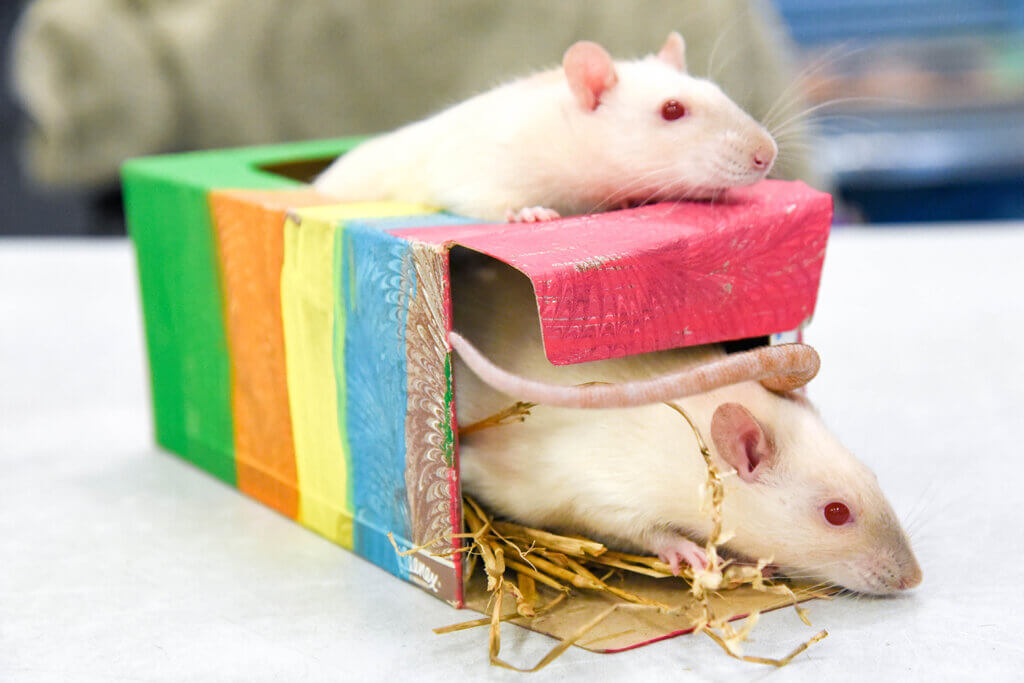Overview
“Where I live”
In spite of their scientific name, which translates to “Norway rat,” this species was native to northern China. Today, however, these rats are found anywhere humans live, except Antarctica.
“How I live there”
Norway rats are omnivores, a trait that allows them to exploit a wide range of food sources. When the opportunity arises, they will prey upon chicks, mice, small lizards, eggs, and fish. But they will also forage for tubers, roots, fruits, and seeds. In fact, rats can survive on just about any type of food. This ability has made it possible for them to flourish throughout the world, particularly in urban areas where they find an abundant supply of food discarded by people.
Rats are quite social, and can live in large groups of 100 individuals or more. They maintain bonds within their groups through grooming one another (“allogrooming”), huddling (direct body contact), and scent marking. These groups live in burrows or in artificial below-ground systems such as sewers.
“Making my mark”
In spite of their negative reputation, rats have impressive abilities. Norway rats are excellent swimmers, and are also highly intelligent. Their high learning capacity allows them to navigate complex burrow systems and to remember extensive foraging trails. They also have highly developed senses of smell and hearing. Rats use their keen sense of smell not only to locate food, but to distinguish between individuals in a group. They communicate extensively through vocalization, producing sounds up into the ultrasonic range–beyond the range most humans can detect.
“What eats me”
Rats have a long list of predators including snakes, weasels, birds of prey, dogs, cats, and humans.
Raising Young
The ability to reproduce quickly and prolifically is an adaptive strategy for species that are frequently preyed upon by larger animals. Norway rats use this reproductive strategy, breeding up to six times per year. Female rats will care closely for their young, nursing them for around 40 days, and closely associating with them for up to 2 months after. A female Norway rat can be both pregnant and nursing at the same time–an important adaptation for producing multiple litters per year. Multiple females may also nest communally, caring for each other’s young.
Taxonomy
- Kingdom: Animalia
- Phylum: Chordata
- Subphylum: Vertebrata
- Class: Mammalia
- Order: Rodentia
- Family: Muridae
- Genera: Rattus
- Species: norvegicus
What is an Animal Ambassador?
The Maryland Zoo refers to its special collection of education program animals as “Animal Ambassadors.” The Zoo currently cares for more than 60 Animal Ambassadors, representing more than 40 species, both native and exotic. These animals are managed separately from the rest of the Zoo’s collection and cannot be seen on exhibit at the Zoo. However, many can be seen up close and personal on a rotating basis at Creature Encounters, the Zoo’s outdoor education center; at camp and school programs at the Zoo; as featured participants in community-based Outreach programs; and at special events on and off Zoo grounds.
Animal Ambassadors spend countless hours working with their human handlers, developing bonds of trust and communication that will allow them to appear in front of audiences large and small. They are not show animals. They behave naturally, focusing audiences’ attention on their natural behaviors and adaptations and giving living, breathing meaning to concepts and topics that students may be studying.
Animal Ambassadors travel all over the state of Maryland and beyond, and many also make local and national media appearances, educating about wildlife while representing the Zoo and its commitments to animal welfare and conservation.
What is The Animal Embassy?
The Animal Embassy at The Maryland Zoo is an off-exhibit area that is not open to the public. It is where the Zoo’s “Animal Ambassadors,” or education program animals, live. The Embassy is home to more than 60 individual animals representing more than 40 different species. It is staffed by its own dedicated group of keepers and volunteers and has both indoor and outdoor living space for the animals.

